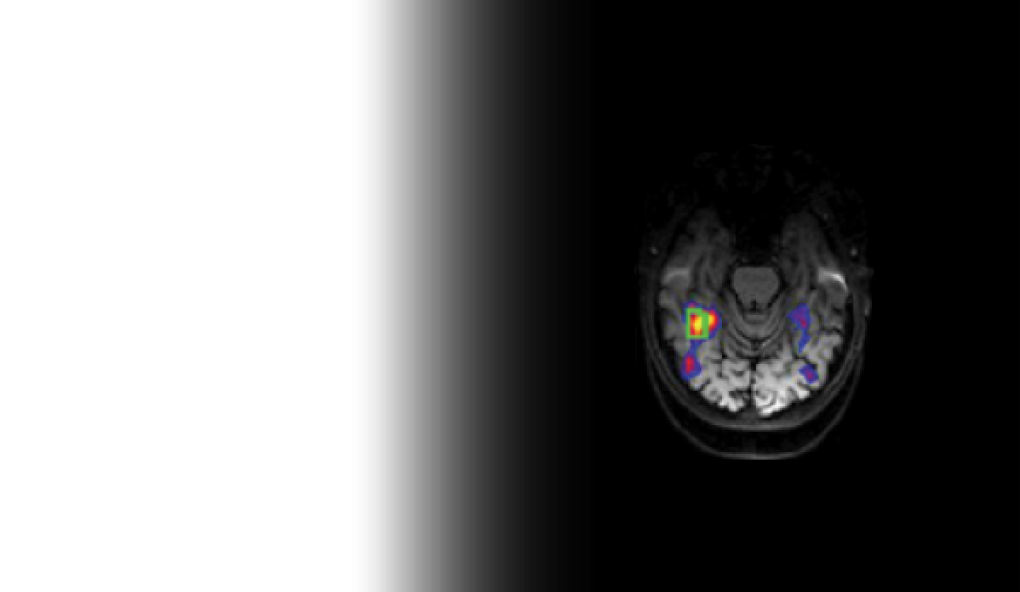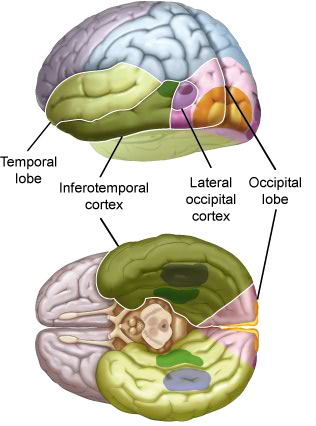Chapter 4. Modular and Distributed Representations
4.1 Title slide

Modular and Distributed Representations
Simulate an experiment showing that object representation in the brain is both modular and distributed.
CLICK ANYWHERE TO BEGIN
In this fMRI image, the vigorous brain activity outlined in green occurred in response to viewing faces. The activity is within a region called the fusiform face area, because it's in the fusiform gyrus in the inferotemporal cortex and seems to constitute a module specialized for representing faces.
Photo: Nancy Kanwisher, Josh McDermott, and Marvin M. Chun, The Fusiform Face Area: A Module in Human Extrastriate Cortex Specialized for Face Perception, Figure 3. The Journal of Neuroscience, 17(11): 4302 - 4311. (1997)
How Are Objects Represented in the Brain?
Evidence for modular coding comes from fMRI experiments showing that viewing certain categories of objects can strongly activate specific brain regions. For example, experiments have shown that one region of the IT cortex responds strongly to faces but not to other categories of objects. Researchers have argued that this region constitutes a module specialized for representing faces and have called it the fusiform face area (FFA) because it’s located on the fusiform gyrus along the lower surface of the temporal lobe. Other proposed modules include the parahippocampal place area, which is activated by buildings and outdoor scenes, and the extrastriate body area, which is activated by human and animal bodies and body parts, but not by faces.
Even though neurons specialized for representing objects of a certain category might tend to be clustered together, neurons in other regions might still carry information about whether a viewed object belongs to that category. Indeed, researchers have found that by analyzing the spatial distribution of cortical activity within a large swath of the IT cortex, they could predict with high accuracy what object category was being viewed, even when the region where brain activity was greatest was excluded from the analysis. For example, when analyzing brain activity in response to viewing faces, they excluded activity in the FFA and found that they still could determine when faces were being viewed.
Clearly, brain activity outside proposed object-specific modules contains reliable information about object category, which suggests that the representation of faces and other objects is more distributed than is presumed by a strictly modular coding view. Also, the sheer number of visual object categories that people can recognize makes it unlikely that each one has its own specialized module in the brain: there doesn’t seem to be enough brain for all the modules that would be required. Overall, it seems likely that the brain represents certain types of objects via modular coding but that distributed coding also plays a significant role, even with those types of objects.
4.2 Explain
Representations of visual objects are produced by neural activity in the temporal and occipital lobes, especially by activity in the inferotemporal cortex and lateral occipital cortex. Particular areas within these two regions of the cortex are thought to function as modules, specialized for representing particular categories of objects, such as faces, places, and human and animal bodies.

4.3 Explain
In this simplified experiment, you're using fMRI to study neural activity in the brains of participants viewing one of three different types of stimuli: a face, a place, or a body part. Begin by clicking on a stimulus to present to participants. Drag the stimulus to the ‘Stimulus Presented’ box. You'll see the results as a pattern of neural activity in these simulated fMRI images of the occipital cortex and inferotemporal cortex, averaged across a number of participants. Click VIEW RESULT to see as many as six of your most recent results.
4.4 Explain
4.5 Explain
How Are Objects Represented in the Brain?
Two main ideas have been proposed about how objects are represented in the brain: modular coding and distributed coding. According to the modular coding view, specific parts of the inferotemporal (IT) and occipital cortex along the ventral visual pathway are specialized for representing objects of specific categories (e.g., faces). These specialized portions of the cortex are sometimes referred to as modules. In contrast, the distributed coding view holds that, regardless of category, objects are represented by the pattern of activity across relatively wide expanses of the cortex along the ventral pathway.
Evidence for modular coding comes from fMRI experiments showing that viewing certain categories of objects can strongly activate specific brain regions. For example, experiments have shown that one region of the IT cortex responds strongly to faces but not to other categories of objects. Researchers have argued that this region constitutes a module specialized for representing faces and have called it the fusiform face area (FFA) because it’s located on the fusiform gyrus along the lower surface of the temporal lobe. Other proposed modules include the parahippocampal place area, which is activated by buildings and outdoor scenes, and the extrastriate body area, which is activated by human and animal bodies and body parts, but not by faces.
Even though neurons specialized for representing objects of a certain category might tend to be clustered together, neurons in other regions might still carry information about whether a viewed object belongs to that category. Indeed, researchers have found that by analyzing the spatial distribution of cortical activity within a large swath of the IT cortex, they could predict with high accuracy what object category was being viewed, even when the region where brain activity was greatest was excluded from the analysis. For example, when analyzing brain activity in response to viewing faces, they excluded activity in the FFA and found that they still could determine when faces were being viewed.
Clearly, brain activity outside proposed object-specific modules contains reliable information about object category, which suggests that the representation of faces and other objects is more distributed than is presumed by a strictly modular coding view. Also, the sheer number of visual object categories that people can recognize makes it unlikely that each one has its own specialized module in the brain: there doesn’t seem to be enough brain for all the modules that would be required. Overall, it seems likely that the brain represents certain types of objects via modular coding but that distributed coding also plays a significant role, even with those types of objects.
4.6 Test - single choice
Select your answer to the question below. Then click SUBMIT.
Question
ftQCvZznkyvqbFFjxP9jW/zNxVDc0WhAxNUhUG/StZkJ6Mqklz6HfN3ke985kr8Zx1/oNKKEpB9vLscfN4ciIqy1c1hnWk4Iqk3RzBulzki8lS7XO/gsFFu0GA/zncVSQy0cZo4CK2YtrxxRA0sgVTkqmVn/A07A6FLqnJTXeNzUdGnOtbZtXBrn120Gu3RS1pJgBLE9gYsWQSZGj6mvG7UNWJSpO9mgrBKI9YwGXtMqLS2S8N4jum03ahKDgKE7HavDqYyNMVmpHoFsQRMuVD1E0vHHVXRujQz2bHR+6s3wy+nFNbfK6bnX5VSHbB2xKCTKANtPMwcAu8meQf/6lu8jYPHaehaEOj16FmA+hfE7/aiG9Jx4Kam2r9sRJPM9SldI2Sd9jcFdUgu8AoY5ELtV73Lfr1YTaYn6olIL3wSNni5pJpVk039D4dxS82VCWpgBz09K4Nk2uJDQiI/ecryuqqEFuV86TcwjrAAPyFG1qYgWm/RrCMkGdfOeE7wijtKzLFulB7nMpQEa2WWymfnZz5z01cxlM9blKMGIFJr4mJdvugmJYS2YmBNh4pHfkzs+FuYjZsPqbyQY2iVAQtBkf/wGlJD7NWyayoTy2wrHwIpCjYgQJ8rzCS2pDdvqhcI7c6O8hCIsuUW1I6aElEmwqyRLuBHB5ZRyxIPkw431nbJZXFdPSo3LScMUAO9hSKx1X2FLlp56Ujbg3P1qPxt7/t0Io5iGcFoqmlzTiJZU2ILnGfOy9a+h0VfKYlMkW2Yng6XLximg32cZlHtkEAbHHHSVvus2UVC41t8XT3VW3wuEntIEPNQ0hOQIwM1HBoYhSKo+1FncN1ps9G3saqvP7LwHNJZJGNt8Gk8AORxKowh3nE7RIj2z3I+9DDgpTiph7ltOuIICUiZApMMMTvRfxFzVHiusjTDBMeTGEmO2XmNvpcjQuICfa/r7bRuD8+kJxcvEN360qewEzh0PIJfXINjZBumPI85ucKRM1Lbv1296n3h9B0PMyBH7p8qNOp3BeyilXhiCwmREzcPYq3XZvkKRpPCreKRNGPW5Htlb3p71gLop4Vjr0pMQzWDgcAUGMS7/uhzcF5/A/O3DscKcHUNa6USV7ssqJBYO73UPBOIp23RVa42COHSULIbEgE2NpuBQ/p+xx9dhnSMi7UUDBkPUtGccNnPVThayFvhPIVIbMJXYdrk2CuhGQ8FmUis0mhRQJEWz3Skt+JBOxR1UIrAYFlnxFb9lY8od+xhhqvOkSXQ8y9XyBElIEZDl6jeuV4WMh4b8cDbA/DSogMxzBRxTHkF2wfZ9+CqXuidAWDqU5feB8FqeU2fUs2QW47eUujCIQMgrxrpo+BWhuemywLU=The correct answer is C.
Click EXPLAIN if you want to review this topic.
4.7 Test - single choice
Select your answer to the question below. Then click SUBMIT.
Question
lMM+5D3F71B/dA/YA2+RJEkgi9wHB+kHDxa2JR5skoH6Bd4Y33D1GoV3oKbcv9WE/BXRFEqe3ghgsm7nvnkfW7iZ2WH0nKEMA6gGVUqrVxHiUcgRK5D9RfnXBvvk7Kmt3DViK07w6E5ZFEIXUOzGO0k8tWFd6abMPut9lIcXkS1dQfkIgT4fObNilxHLBTJU66gcA5LqMZzC+2TTTBeFTuKBsO1QqkdRlsaOoVhSBPN6TpPshzqOCl3AVdZpmzCWB0E/jNbEcJtczjQlmMo3vtmd+BEqimUbLPZlFnQh8gaSiSfKnUKqoyrOiB/KK6ipUy+vOiEFA5CvHcEk5t2LNbDyc7cSKRLWfIVzNamv3d0i2MTQwMd111cUIjDLUa6o8g+nKvMkki2Gu4xHkVy9kZEa9PC/zIIlrRp9sL1u+gEyTRyS5hDQb8y9Xsg4fmd+gFtJuGP3vsmkQDr04+gr5XZBeLY/jT5S0u1Jbe2SlCmxjScjdn2QADuWnjKC/L5LMCe7g0MeLHsbXpCkvjn7STBjeyxev/IeyHi5ApvV7v02MQKHPA3Q5J4uA8IzP+naMu2NbrHh13aatwtNUZ+FM42mBvQLmnpH+nixlw==The correct answer is A.
Click EXPLAIN if you want to review this topic.
4.8 Test - single choice
Select your answer to the question below. Then click SUBMIT.
Question
W7ouvpniBxlmDRUGP3qpxFS2+3yv8aF5hO2zBUDfSkniOtPlbVG4FLDcsXYnvNNXStzTneVcfBwo7SRX6rDTFpMRi9VYLrSg8DBkb9KUNtWV7usVDSrYdXAwdBWfd3QQ6A0KC2Wm1xPcedR+Bs5WzZER/4ox2rd9lFmf6ZYKunwNDlhfWWClam+SiS3reK/T5wkh6T1+PohmqXUkMR54pAL30QbnWeFx4TcKs+PacClm+9v76MYoQePed3suLFMj3mSJTPD+T5+aeDEWbYJMMu1rULCprwE3mFVqBmsPIXDWpgD847bcrtYac1hZ08xgCPjh/f8vJWx0MtsL+DI3ONZ90JqJcP4KQs0sduLKaNdt2YZ1EE2NFwqaPep+MM6Qx3wZmZcLwd0mIKpaEHSw8vBF09UHEzzShcT21BGavP4YLoGsaH4G3xJugv7k5AEGiY1RVjdwqXhdTLJBNpSezIkaMI62sLP7qSJamZZ58oBI0DKNvUfxXzrW6EAVjiUO5Ntxia1FLlV5zZaGZXI5Igr1HIVoE8aIviwxD0ttK6tAo2LMEoMvrT40VMlF636yVV+IZRrphCaxB9Z57Qver+mh+f7ADGZ2/7XaWQpLzQGxkrkDowWbVBuywkUdENotAloy5OHYFznXIWqJnVjINiKZKQx3xZY9VhW26tHf48uV32jWSxcjPjdy80NCBPlullBXzpYixWrKm1mygq0Uz3MNdCcdQf0MNC7nsVG2xEAnr7N9rvjQi+3dyrQF327L31dClhkz+yfeGgFHNej/BBVRa5Rei88nOAv0HYYvUUR1opdIThe correct answer is B.
Click EXPLAIN if you want to review this topic.